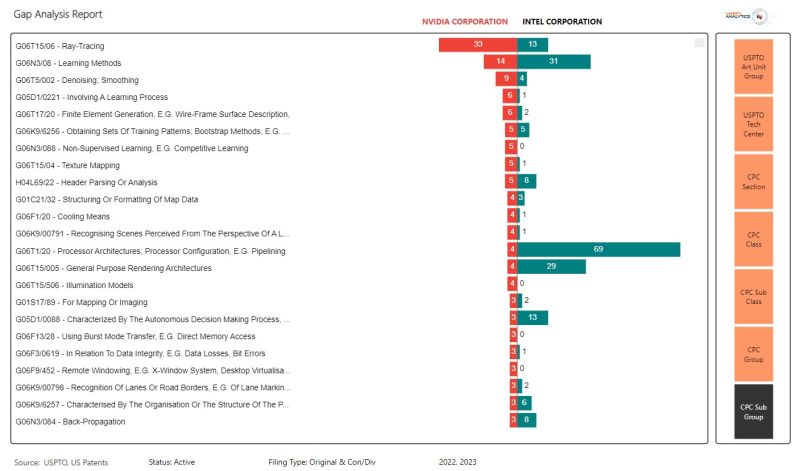Leveraging AI in Gap Analysis Reports
Gap Analysis Reports are instrumental for companies to understand the comparative strengths and weaknesses in their patent portfolios. At Harrity & Harrity, we have begun to incorporate generative AI technology like ChatGPT to rapidly identify and summarize these crucial differences between portfolios, based on data provided by the Harrity Analytics Team. The use of AI in this context is not just an experimental venture; it presents a significant opportunity to make the patent analysis process more efficient, quicker, and potentially less costly, particularly in matters of litigation and licensing.
Our Patent 300® Dashboard helps users easily filter between companies and technology areas for easy to view gap analysis, which AI can then quickly delineate. Let’s take a case study that involved comparing the patent portfolios of NVIDIA and Intel Corporation. This analysis highlighted several interesting differences and competitive focuses between the two tech giants. For example, NVIDIA has a noticeable lead in ray-tracing technology with 33 patents, while Intel trails with only 13. When it comes to learning methods, a domain essential for artificial intelligence, Intel surprisingly leads with 31 patents as opposed to Nvidia’s 14. In the areas of texture mapping and processor architectures, both companies appear neck-and-neck, each holding five patents, suggesting a mutual recognition of the importance of these technologies. Furthermore, while NVIDIA has made some headway in cooling technologies with four patents, Intel has none. On the flip side, Intel dominates in the domain of remote windowing with eight patents, dwarfing Nvidia’s single patent. Lastly, in terms of the organizational structure of processors, Intel holds twice the number of patents that Nvidia does, with six against three.
The potential implications of this rapid, AI-driven comparative analysis are significant. Firstly, by providing quick and accurate insights into patent portfolios, the AI can significantly reduce the time and financial resources usually required for litigation and licensing processes. Secondly, these insights can also be instrumental for a company’s strategic planning, particularly for directing R&D investments and identifying areas for competitive positioning. Finally, when aggregated across multiple analyses, this data may also serve as an industry barometer, signaling where innovation is heating up and where it is cooling down.
Overall, the integration of generative AI technology like ChatGPT in the patent analysis process offers promising advantages. By parsing large sets of complex data with both speed and accuracy, we are poised to provide our clients with more cost-effective and timely solutions without compromising the quality of insights crucial for strategic decision-making. The challenge now lies in considering how to further harness this technology.
Could there be other facets of the patent field where the capabilities of generative AI could be further explored for better efficiency and cost-effectiveness? Let us know your thoughts!
Check out our Patent Analytics services HERE.

